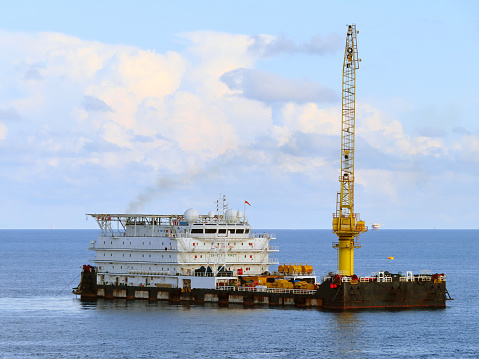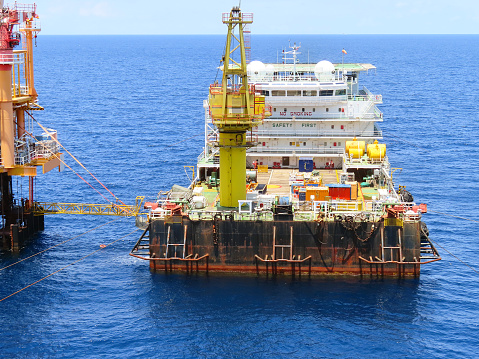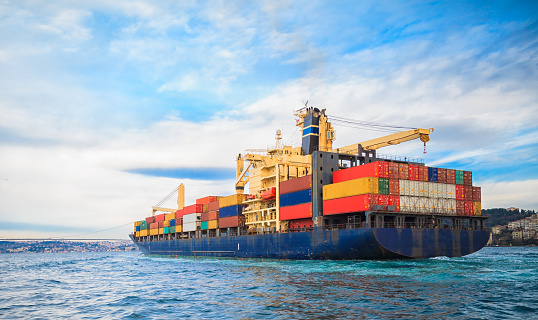An Accommodation Barge is a non-self-propelled manned vessel transporting more than 36 people, excluding crew members, who are industrial employees working in coastal, offshore, or similar jobs.
Only when the barge is tied or otherwise secured to a spot is it designed to host these people.
Only members of the crew required for the transit operation are to be onboard during the accommodation barge’s transit.
Common meanings that are associated with barges
Accommodation Spaces
Accommodation spaces can be referred to places such as :
- public spaces
- corridors
- lavatories
- cabins
- offices
- hospitals
- cinemas
- game room
- pantries
These spaces are usually occupied by the crew members that are present on the barge.
Crew
All personnel hired aboard the accommodation barge to provide maintenance and operation of the barge, its machinery, systems, and arrangements, or to give services to other people on board the barge which are referred to as crew.
Displacement hull
A displacement hull is a structure that is fully supported by the buoyancy of the water it transports.
Industrial personnel
Individuals from the offshore or related industries who are temporarily accommodated aboard the barge are known as industrial personnel.
These individuals may include crew members or industrial personnel from other boats, drilling units, or offshore sites, in addition to members of the accommodation barge’s crew.
Machinery spaces of category A
All areas and trunks to such spaces that include internal combustion type machinery with a total power of not less than 375 kilowatts, or any oil-fired boiler or oil unit, and trunks to such spaces, are considered Machinery Spaces of Category A.
Machinery spaces
Machinery spaces are all basically machinery spaces of category A and all other spaces containing :
- boilers.
- oil fuel units.
- steam and internal combustion engines.
- generators and major electrical machinery.
- oil filling stations.
- refrigerating.
- stabilizing.
- ventilation and air-conditioning machinery.
Noncombustible material
When heated to about 750°C (1382°F) using an approved test technique, noncombustible material does not burn or give off flammable gases in sufficient quantity for self-ignition while any other material is considered a combustible material.
Non-Self-Propelled
Non-self-propelled refers to a barge with or without propulsion machinery (thrusters) that is used for positioning short field moves or providing assistance while being towed to or from a location.
Scope and classification of barges
Flag State Administration
The flag Administration with which the accommodation barge is registered, or the Administration within whose territorial authority the accommodation barge is planned to operate, may impose extra restrictions.
Approval of safety plans of the accommodation barge is as follow :
- fire safety measures.
- life-saving appliances and equipment.
- radio communication installations.
- subdivision and safety.
If such permission can be adequately verified, administration in accordance with criteria equal to those by class may be deemed as complying with the class requirements.
Submission of Plans
Before beginning construction, the plans and specifications listed in the following sections, as well as any supporting computations, must be provided.
Hull Plans
Unless otherwise requested, hull plans should be submitted for approval.
Machinery and Systems Plans
Plans for equipment, pumps, and piping systems, as well as electrical systems, should be submitted for evaluation.
Dimensions, manufacturers, and sizes of standard authorised appliances, as well as welding details and other information, must be represented as clearly and completely as feasible on the drawings.
Safety Plans
- Plans depicting the structure’s fire safety.
- Fire pumps, fire mains, fire detectors, fire alarms, and a fire-extinguishing system are all examples of fire-fighting equipment.
- Life-saving devices and equipment, as well as rescue boats.
- Installations for radio communications.
- subdivisions and safety.
Stability, Loading, and Operating Information
Ballast, fuel, supplies, and hold arrangement and capacities must be given, as well as a summary and distribution of fixed and variable weights for each evaluated condition and information on all loaded and ballasted circumstances in which the accommodation barge may function.
Stability calculations proving that the accommodation barge satisfies the stability standards in all loading and ballast circumstances must be submitted for evaluation in line with the regulations.
Operating Manual
For the instruction of the operational crew, an operating handbook that is compatible with the facts and criteria on which classification is based should be put aboard the accommodation barge.
Accommodation barges that have been licensed and designed for limited or restricted services must contain the relevant service limitations in the Operating Manual.
The operating manual is to include the following information :
1 – A basic description of the barge, covering its key dimensions and features as a lightship.
2 – Summaries of approved transit and operation conditions including :
- Environmental constraints include wave height and period, wind velocity, current velocity, and the barge’s service temperature.
- Deck loadings, mooring loads, icing loads, fluctuating loads, cranes, and helicopter types for which the helideck is constructed are all factors to consider.
- Watertight and weathertight closures are disposed of.
3 – Vessel information.
- Drawings of the general layout.
- Boundaries that are waterproof and weathertight, as well as the position of exposed holes and watertight and weathertight closures.
- Permanent ballast types, locations, and amounts.
- Deck loadings that are permitted.
- Each tank’s capacity, the center of gravity, and free surface correction.
- Curves of hydrostatic pressure or their equivalent.
4 – Advice on how to maintain appropriate stability and how to use stability data.
5 – Lightweight changes should be recorded on a regular basis, according to the guidelines.
6 – Examples of permissible loading circumstances for each mode of operation, as well as directions for creating other acceptable loading conditions, such as the vertical components of the anchor cable forces.
Conclusion
In conclusion, we have discussed common meanings that are associated with barges such as accommodation spaces, machinery spaces as well as non-combustible materials.
We also touched upon the scope and classification of barges which includes flag state administration, submission of plans as well as operating manual.
These are some questions related to what are accommodation barges.

Business Director
A graduate (Business) from KDU, Jason Tan, is the current Business Director (Sales) for MGS Icestorm and has been associated with the company for the past 10 years.
With over 13 years in the shipping industry, he has had a significant contribution to Malaysia’s oil and gas industry in the engine and boat supply sector.
His expertise includes managing offshore catering business, offshore reefer containers, AI technology, offshore gas tanks, A60 pressurized cabins, etc. His contributions have helped establish MGS, in partnership (joint venture) with Thermo King and Honeywell to produce state of art Offshore Reefer Container products.




